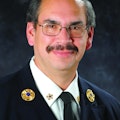Recently, a small plane and a sightseeing helicopter collided over the Hudson River between New York and New Jersey. Nine people were killed. The accident occurred only a short distance down river from where the "miracle on the Hudson" took place earlier in the year when a jetliner landed in the river after losing both engines in a bird strike. In that incident, all of the passengers and crew survived. Ferries and other watercraft including fire, police and Coast Guard boats responded to the scene and safely removed the occupants (see photo).
In the recent accident, the passengers and pilots were not so lucky. FDNY Marine 1 Alpha was one of the first on the scene, as in the earlier incident. I listened to my scanner as Ladder 5 reported the verbal alarm to the Manhattan fire dispatcher over the radio. Another massive response of multiple agencies took place from both sides of the river, but this time there were no survivors, no miracles. As reported last month in Firehouse®, the tragic passenger train wreck in Washington, DC was similar in nature to the passenger/freight train wreck in Los Angeles last year. A horrific scene greeted rescuers on both coasts. The long and difficult job of searching for, extricating and removing the victims took its toll on rescuers and first responders.
A few weeks ago in Hawthorne, NY, numerous fire and EMS responders were dispatched to a multi-vehicle accident on the Taconic Parkway. Reportedly, a woman who, after an autopsy, was found to have been intoxicated drove for several miles in the wrong direction on the highway. Her vehicle collided with another vehicle and eight people died. Only a 5-year-old boy survived. I heard about the crash on the local news. When the Hawthorne location was mentioned, I realized that I knew the chief of that fire department, Joe LaGrippo. Later, I saw him being interviewed on the evening news. Initially, I didn't want to disturb the chief after what he and the other responders had been through, but a few days later he called me. He said he remembered me telling him about a five-person fatal accident to which I had responded several years ago as fire chief.
Chief LaGrippo described the scene, the traffic, the chaos and the devastation they came upon. The 5-year-old survivor was located after someone heard him near the wreckage. A person came up to LaGrippo and said there was another car involved that was farther down the road, so he asked a police officer to check it out. The officer reported back that there were three fatalities. Chief LaGrippo said he knew that, but the officer said no, there are three more. Fire, police and EMS workers were affected in some way after viewing the horrific scene. Critical incident stress debriefing was held to console the responders. Chief LaGrippo told an interviewer that the scene of the horrific crash was something no human should have to see. The emergency services of this country respond to millions of calls every year. Disasters occur all the time. Maybe the magnitude and the circumstances are different, but the emotional impact on emergency responders is one constant. The carnage comes with the territory.
Two other amazing stories within this issue take a brief look at the 150th anniversary of the Chicago Fire Department and the 75th anniversary of the Chicago Union Stockyards fire that occurred on May 19, 1934. The stockyards measured one mile square. As for the massive amount of fire and rapid spread, the deputy chief first on scene was quoted as saying, "I went to pull a 5-11 and special call for five more engines, but by this time the fire alarm box had burned down and I had to send a messenger to the firehouse to send in the additional calls." The 31½-hour battle required the response of 100 Chicago engines, destroyed six square blocks and caused $6 million in damage. Thirty-one suburbs responded into Chicago to fight the fire or cover empty fire stations.
Sadly, the city of Chicago has suffered many serious fires, including the famous Chicago Fire on Oct. 8-9, 1871, which destroyed much of the city and caused 250 deaths. The Iroquois Theatre fire, which killed 602 people on Dec. 30, 1903, was the deadliest public-assembly fire in U.S. history. One of the nation's deadliest school fires killed 95 at the Our Lady of the Angels School on Dec. 1, 1958. The famous McCormick Place exhibition hall was destroyed in a fire that caused $50 million in damage on Jan. 16, 1967. Within the history coverage are some amazing facts that I never knew regarding the loss to Chicago Fire Department property after the great 1871 conflagration. See page 120 for a very interesting read. Thanks to Jeffrey L. Stern and Kenneth Little for their research.
Another special feature in this month's issue is an exclusive interview with new FEMA Administrator W. Craig Fugate, who was appointed in May. As the interviewer, Chief Charles L. Werner, says in his introduction, Administrator Fugate's "experience in the fire and rescue community combined with his lead role in Florida's Emergency Management Program provide unique and positive insights on how FEMA can effectively accomplish its mission." Learn more about what's ahead for FEMA and the fire-rescue service on page 70.
For comments, ideas and suggestions, please contact us at [email protected].
About the Author

Harvey Eisner
Editor Emeritus
HARVEY EISNER was named Editor Emeritus of Firehouse® after serving 15 years as Firehouse's Editor-in-Chief. He joined the Tenafly, NJ, Fire Department in 1975 and served as chief of department for 12 years. He was a firefighter in the Stillwater, OK, Fire Department for three years while attending Oklahoma State University. Eisner was an honorary assistant chief of the FDNY and program director for the Firehouse Expo, Firehouse World and Firehouse Central conferences. He covered many major fires and disasters and interviewed numerous fire service leaders for Firehouse®